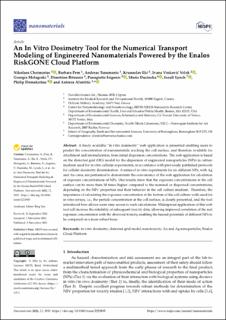| dc.contributor.author | Cheimarios, Nikolaos | |
| dc.contributor.author | Pem, Barbara | |
| dc.contributor.author | Tsoumanis, Andreas | |
| dc.contributor.author | Ilic, Krunoslav | |
| dc.contributor.author | Vrček, Ivana Vinković | |
| dc.contributor.author | Melagraki, Georgia | |
| dc.contributor.author | Bitounis, Dimitrios | |
| dc.contributor.author | Isigonis, Panagiotis | |
| dc.contributor.author | Dusinska, Maria | |
| dc.contributor.author | Lynch, Iseult | |
| dc.contributor.author | Demokritou, Philip | |
| dc.contributor.author | Afantitis, Antreas | |
| dc.date.accessioned | 2022-11-28T09:04:56Z | |
| dc.date.available | 2022-11-28T09:04:56Z | |
| dc.date.created | 2022-11-24T09:25:55Z | |
| dc.date.issued | 2022 | |
| dc.identifier.citation | Nanomaterials. 2022, 12, 3935. | en_US |
| dc.identifier.issn | 2079-4991 | |
| dc.identifier.uri | https://hdl.handle.net/11250/3034366 | |
| dc.description.abstract | A freely available “in vitro dosimetry” web application is presented enabling users to predict the concentration of nanomaterials reaching the cell surface, and therefore available for attachment and internalization, from initial dispersion concentrations. The web application is based on the distorted grid (DG) model for the dispersion of engineered nanoparticles (NPs) in culture medium used for in vitro cellular experiments, in accordance with previously published protocols for cellular dosimetry determination. A series of in vitro experiments for six different NPs, with Ag and Au cores, are performed to demonstrate the convenience of the web application for calculation of exposure concentrations of NPs. Our results show that the exposure concentrations at the cell surface can be more than 30 times higher compared to the nominal or dispersed concentrations, depending on the NPs’ properties and their behavior in the cell culture medium. Therefore, the importance of calculating the exposure concentration at the bottom of the cell culture wells used for in vitro arrays, i.e., the particle concentration at the cell surface, is clearly presented, and the tool introduced here allows users easy access to such calculations. Widespread application of this web tool will increase the reliability of subsequent toxicity data, allowing improved correlation of the real exposure concentration with the observed toxicity, enabling the hazard potentials of different NPs to be compared on a more robust basis. | en_US |
| dc.language.iso | eng | en_US |
| dc.rights | Navngivelse 4.0 Internasjonal | * |
| dc.rights.uri | http://creativecommons.org/licenses/by/4.0/deed.no | * |
| dc.title | An In Vitro Dosimetry Tool for the Numerical Transport Modeling of Engineered Nanomaterials Powered by the Enalos RiskGONE Cloud Platform | en_US |
| dc.title.alternative | An In Vitro Dosimetry Tool for the Numerical Transport Modeling of Engineered Nanomaterials Powered by the Enalos RiskGONE Cloud Platform | en_US |
| dc.type | Peer reviewed | en_US |
| dc.type | Journal article | en_US |
| dc.description.version | publishedVersion | en_US |
| dc.rights.holder | © 2022 by the authors. Licensee MDPI, Basel, Switzerland. | en_US |
| dc.source.volume | 12 | en_US |
| dc.source.journal | Nanomaterials | en_US |
| dc.identifier.doi | 10.3390/nano12223935 | |
| dc.identifier.cristin | 2079687 | |
| dc.relation.project | EC/H2020/101008099 | en_US |
| dc.relation.project | EC/H2020/814425 | en_US |
| dc.relation.project | NILU - Norsk institutt for luftforskning: 119011 | en_US |
| dc.source.articlenumber | 3935 | en_US |
| cristin.ispublished | true | |
| cristin.fulltext | original | |
| cristin.qualitycode | 1 | |

